When it comes to traditional Mongolian dairy products, one unique delight that stands out is Byaslag cheese. Crafted with centuries-old techniques, Byaslag cheese is a creamy and authentic delicacy that showcases the rich dairy culture of Mongolia. Whether you are a connoisseur of artisanal cheeses or simply love exploring new flavors, Byaslag cheese is a must-try.
Unlike its Norwegian counterpart, Byaslag cheese is made using traditional Mongolian methods. The cheese is crafted by skilled artisans who carefully source high-quality milk and use meticulous processes to create a cheese that is unrivaled in taste and texture. Its creamy mouthfeel and delicious flavor make it a delight for both cheese enthusiasts and newcomers to Mongolian cuisine.
When it comes to finding the best Byaslag cheese, seeking out premium producers is key. These producers prioritize quality and authenticity, ensuring that every bite of Byaslag cheese is a true culinary experience. So whether you enjoy it on its own, pair it with bread or fruits, or incorporate it into your favorite recipes, Byaslag cheese is sure to add a touch of Mongolia’s culinary heritage to your dining table.
Ready to indulge in the dairy delight that is Byaslag cheese? Discover the best traditional Byaslag cheese from renowned Mongolian producers and savor the essence of Mongolia’s rich dairy culture.
Mongolian Dairy Culture And Nomadic Traditions
Mongolia’s unique dairy culture is deeply rooted in its historic nomadic lifestyle. The vast grasslands and harsh climates of Mongolia created the perfect environment for herding animals like horses, camels, yaks, sheep, and goats. These animals became invaluable resources for the survival of the nomadic people.
The nomadic lifestyle of the Mongolian people revolved around the herding and care of these animals. They moved from one pasture to another, following the ever-changing availability of fresh grazing land. This nomadic way of life not only allowed the animals to thrive but also shaped Mongolia’s dairy culture and traditions.
Dairy products played a crucial role in sustaining the nomadic diet. They provided a reliable source of nutrition and sustenance, especially during long and harsh winters when fresh produce was scarce. Mongolian herders utilized milk from their animals to create a wide range of dairy products that could be preserved and consumed throughout the year.
These dairy products held significant nutritional value, offering essential vitamins, minerals, and proteins necessary for the nomads’ physical well-being. They served as a critical source of sustenance and energy for the nomadic way of life.
“Mongolia’s dairy culture evolved as a result of the unique nomadic traditions and the diverse range of animals that were herded. Dairy products provided nutrition, sustenance, and cultural significance to the nomadic people.”
The cultural significance of dairy products extended beyond their nutritional value. In Mongolian society, dairy products were deeply intertwined with traditions, celebrations, and religious practices. For example, during festivals like the Naadam Festival, dairy products played a central role in feasts and culinary offerings.
The dairy industry also contributed significantly to the nomadic economy. The production and trade of dairy products provided income for herders, fostering economic stability in the community. In addition, Mongolian dairy products gained recognition for their uniqueness and high quality, attracting markets beyond the nomadic regions.
Mongolian Dairy Products: Nutritional Value And Cultural Significance
Mongolian dairy products offer a wide range of nutritional benefits due to their natural sourcing and traditional production methods. From the creamy texture of yogurt to the rich flavors of cheese, these products are packed with essential nutrients.
| Dairy Product | Nutritional Value |
|---|---|
| Yogurt | Rich in probiotics, calcium, and protein |
| Byaslag Cheese | High in protein, calcium, and vitamins |
| Aaruul | Good source of protein and probiotics |
| Suutei Tsai (Mongolian Milk Tea) | Provides hydration and essential minerals |
These dairy products also hold cultural significance as they are deeply ingrained in Mongolian culinary traditions. They are not just food items but symbols of hospitality, community gatherings, and shared meals. Mongolian dairy products have become an integral part of the cultural fabric, representing the history, heritage, and spirit of the nomadic people.
Aaruul: The Traditional Mongolian Dairy Delight
Experience the unique flavors of Aaruul, a traditional Mongolian cheese that delights the senses with its dried curd texture. Made by fermenting and drying curds sourced from the finest Mongolian milk, Aaruul offers a taste of Mongolia’s rich dairy heritage. This versatile delight comes in various forms, flavors, and textures, reflecting the diverse regions and milk types of Mongolia.
The production process of Aaruul involves carefully sourcing fresh milk, fermenting it to enhance its flavors, and drying the curds under the warm Mongolian sun. This traditional method creates the distinctive hardened texture that sets Aaruul apart from other cheese varieties.
Aaruul is renowned for its exceptional taste, combining the natural sweetness of milk with a subtle tanginess brought about by the fermentation process. Its unique texture adds a delightful crunchiness to dishes and makes it a popular snack on its own.
Aside from its culinary merits, Aaruul also offers numerous health benefits. It is rich in protein, calcium, and beneficial bacteria, making it a nutritious addition to your diet. Whether you enjoy it as a post-workout snack or incorporate it into your favorite recipes, Aaruul is a wholesome choice for the health-conscious.
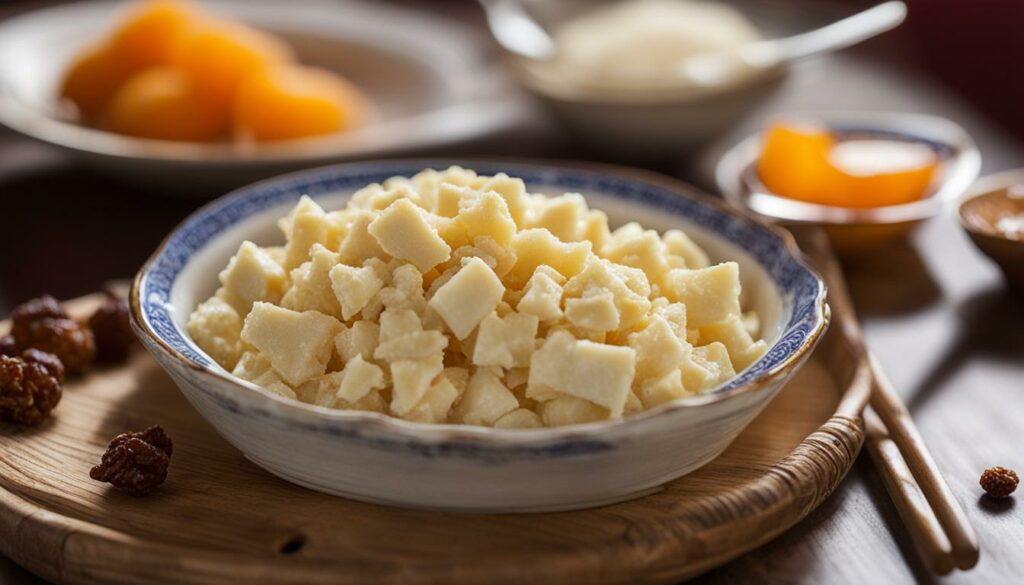
Types of Aaruul
The diversity of Mongolia’s regions and milk sources gives rise to a wide range of Aaruul varieties. Each type boasts a unique taste, texture, and flavor profile, offering a culinary adventure with every bite. Here are some popular types of Aaruul:
- White Aaruul: This classic variety is made from cow’s or goat’s milk and has a mild, creamy taste.
- Shar tov Aaruul: Known for its chewy texture, this variety is made from sour yak or cow milk.
- Dark Aaruul: Made from fermented camel milk, this type has a rich, earthy flavor.
- Flavored Aaruul: Infused with ingredients like dried fruits, herbs, or spices, these Aaruul varieties offer exciting flavor combinations.
Using Aaruul in Your Culinary Creations
The versatility of Aaruul extends beyond being a standalone snack. Its unique texture and flavors make it a delightful ingredient in various dishes. Here are some creative ways to use Aaruul:
- Crumbled over salads or roasted vegetables for added texture and tanginess.
- Used as a topping for soups or stews, offering a savory crunch.
- Incorporated into baked goods such as bread or scones, providing a subtle cheesy taste.
- Mixed into yogurt or smoothies to boost protein and flavor.
- Enjoyed with dried fruits and nuts as a wholesome snack.
Embrace the flavors of Mongolia with Aaruul, a traditional Mongolian dairy delight that captivates with its taste, texture, and health benefits. Whether enjoyed on its own or incorporated into your favorite recipes, Aaruul brings a taste of Mongolia’s rich culinary heritage to every bite.
Suutei Tsai: The Mongolian Milk Tea
Suutei Tsai is a unique and flavorful beverage that holds great cultural significance in Mongolia. Known as Mongolian milk tea, Suutei Tsai is a blend of tea, milk, and salt, creating a distinctive savory taste that tantalizes the senses.
To prepare Suutei Tsai, start by boiling water with tea leaves, allowing it to infuse and develop a rich flavor. Then, add milk and a pinch of salt, carefully balancing the saltiness with the creaminess of the milk. The tea can be made using green or black tea leaves, each imparting its own distinct character to the drink.
Suutei Tsai is not just a beverage; it is a symbol of hospitality, friendship, and everyday comfort. In Mongolian culture, the act of preparing and sharing Suutei Tsai is a ritual, embodying the community spirit and generosity that is deeply rooted in Mongolian traditions.
When sipping on a warm cup of Suutei Tsai, you’ll experience a harmonious blend of flavors. The slight saltiness elevates the natural sweetness of the tea and enhances its depth, while the creamy milk adds a smooth and comforting texture.
Image:

With its unique taste, Suutei Tsai encapsulates the warmth and hospitality that Mongolians are renowned for. It is commonly enjoyed as a morning or afternoon pick-me-up, providing a comforting pause in the day to connect and share stories with loved ones.
Cultural Significance
Suutei Tsai holds great cultural significance in Mongolian society. It is often served to guests as a gesture of hospitality and is an integral part of traditional Mongolian meals, especially during celebrations and gatherings.
Drinking Suutei Tsai is a shared experience, fostering a sense of togetherness and nurturing bonds. Its preparation and consumption reflect the deep-rooted customs and values of Mongolian culture, showcasing the importance of community and connection.
Next time you have the opportunity to try Suutei Tsai, savor each sip and appreciate the rich flavors and cultural heritage it represents.
Cultural Significance And Modern Context
Aaruul and Suutei Tsai hold significant cultural value in Mongolia, being part of social and cultural celebrations like the Naadam Festival. These traditional dairy products play a central role in gastronomy and are deeply ingrained in Mongolia’s culinary heritage.
In modern gastronomy, Mongolian dairy products are being reinvented and integrated into contemporary dishes, showcasing the country’s rich gastronomic traditions. By combining traditional techniques and flavors with innovative culinary approaches, chefs are creating unique and exciting dishes that appeal to both locals and international visitors.
“Mongolian dairy products have a distinct taste and texture that adds depth and complexity to any dish. They are not only delicious but also help to preserve and promote the country’s culinary heritage.” – Chef Bolor
Efforts are also being made to preserve traditional dairy practices through government initiatives and non-profit organizations. These initiatives focus on supporting local farmers and producers, ensuring the sustainability of Mongolian dairy production, and safeguarding the traditional methods of making Aaruul and Suutei Tsai.
The dairy industry plays a vital role in Mongolia’s economy, providing livelihoods to farmers, producers, and artisans across the country. The export potential of Mongolian dairy products contributes to the growth of the national economy and helps to raise awareness of Mongolian gastronomy on the global stage.
| Key Points | Cultural Significance And Modern Context |
|---|---|
| Cultural Celebrations | Aaruul and Suutei Tsai are integral parts of social and cultural celebrations like the Naadam Festival. |
| Gastronomy | Mongolian dairy products are reinvented and integrated into contemporary dishes, showcasing the country’s culinary heritage. |
| Preservation | Government initiatives and non-profit organizations are working towards preserving traditional dairy practices. |
| Economy | Mongolian dairy industry contributes to the country’s economy, providing livelihoods and export potential. |
By embracing and celebrating Mongolian dairy products, we can support the preservation of culinary traditions, contribute to the local economy, and experience the unique flavors and cultural richness that they bring to the table.
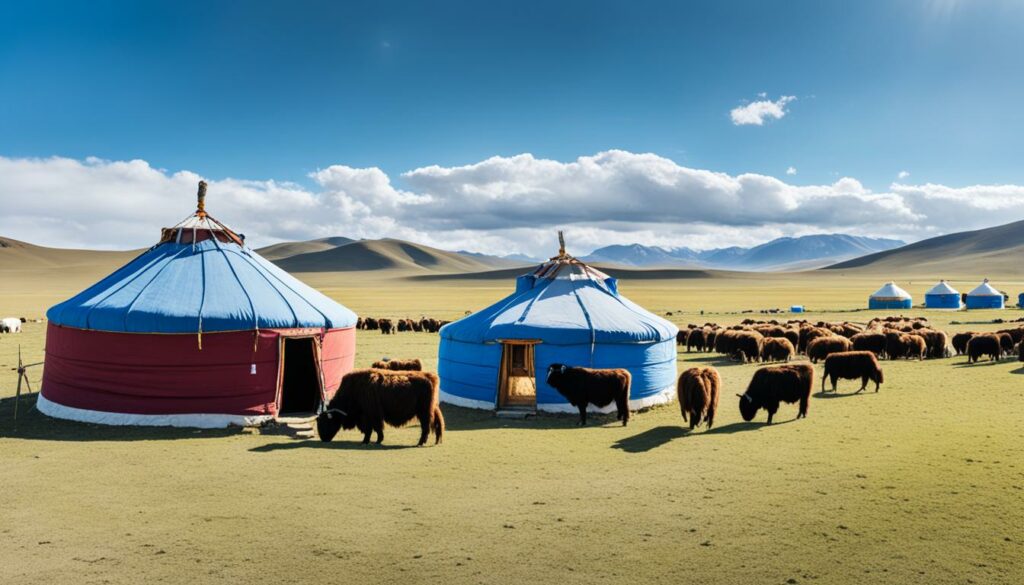
Conclusion
Mongolia’s dairy heritage is a testament to the country’s rich culinary tradition and the warmth of Mongolian hospitality. Byaslag cheese and other traditional Mongolian dairy products have become cultural markers, embodying the history and traditions of the land.
“Exploring and appreciating Mongolian dairy products allows us to delve into a unique culinary tradition that has withstood the test of time.”
The journey through Mongolia’s dairy culture gives us a glimpse into a nomadic lifestyle, where herding animals and utilizing their resources became essential for survival. From the nutritional value and long shelf-life of dairy products to their cultural and religious significance, these delicacies have played a significant role in Mongolian society throughout history.
Byaslag cheese, with its creamy texture and distinctive flavors, is a prime example of Mongolia’s culinary mastery. Whether enjoyed on its own or incorporated into various dishes, it showcases the ingenuity and creativity of Mongolian gastronomy.
As we explore traditional Mongolian dairy products, we celebrate the diversity and resilience of culinary traditions worldwide. Each bite carries stories of nomadic heritage, cultural celebrations, and the rich flavors accumulated over generations.
Let the flavors of Byaslag cheese and other traditional Mongolian dairy products transport you to a land of breathtaking landscapes, vibrant traditions, and Mongolian hospitality.
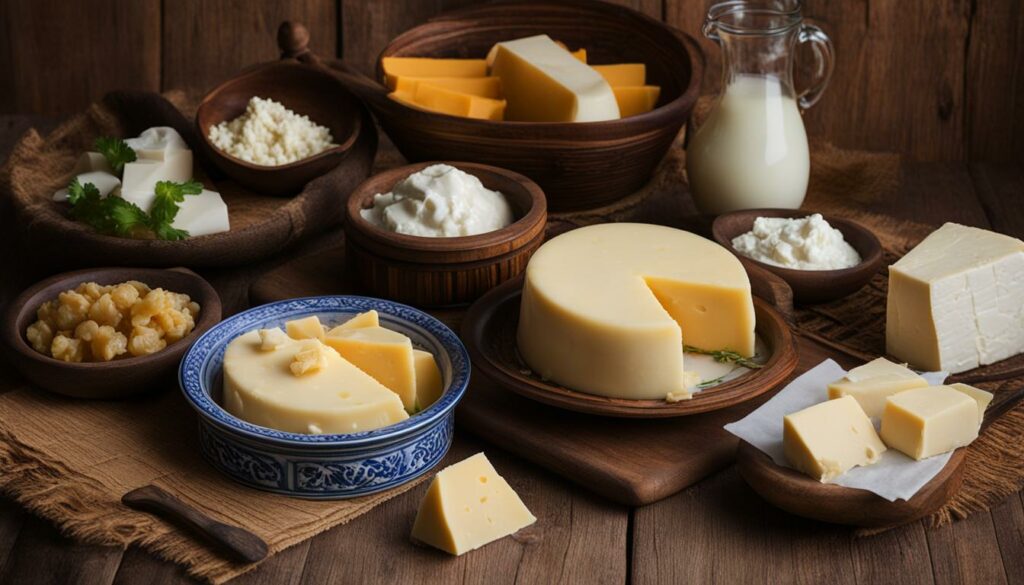
| Key Takeaways |
|---|
| Byaslag cheese and other traditional Mongolian dairy products reflect the country’s rich culinary tradition and nomadic lifestyle. |
| Exploring Mongolian dairy products invites us to celebrate cultural diversity and savor the stories carried by each bite. |
| Mongolia’s dairy products exemplify the resilience of culinary traditions and the warmth of Mongolian hospitality. |
Mongolia’s Culinary Heritage and Nomadic Lifestyle
Mongolia’s traditional breakfast is a reflection of its nomadic lifestyle and the necessity for nourishing, energy-packed meals to fuel the day ahead. With its harsh climate and vast landscape, Mongolia’s culinary heritage has developed around staple foods that provide sustenance and strength to the nomadic herders.
At the heart of a traditional Mongolian breakfast are dairy products, meat, and grains, which offer a balanced and deeply nourishing combination of nutrients. Dairy products, such as milk, yogurt, and cheese, not only provide valuable proteins and fats but also serve as a vital source of hydration. The intensive labor of herding in the Mongolian steppes requires replenishment of these nutrients, making dairy products an intrinsic part of the daily diet.
“Mongolia’s nomadic lifestyle demands nourishing meals to sustain the physical demands of herding and survival.”
Meat, particularly from animals like sheep, goats, and yaks, provides essential proteins and fats that sustain the nomadic herders throughout their arduous daily activities. These meat dishes are often prepared in a variety of ways, such as boiling, grilling, or stewing, to maximize flavor and preserve valuable nutrients.
Grains, such as wheat, barley, and millet, form the foundation of many traditional Mongolian breakfast dishes. Tsampa, a roasted barley flour porridge, is a popular and nutritious choice that provides sustainable energy for the long days ahead. Grains are also used to create bread, pastries, and noodles that accompany various meat and dairy dishes.
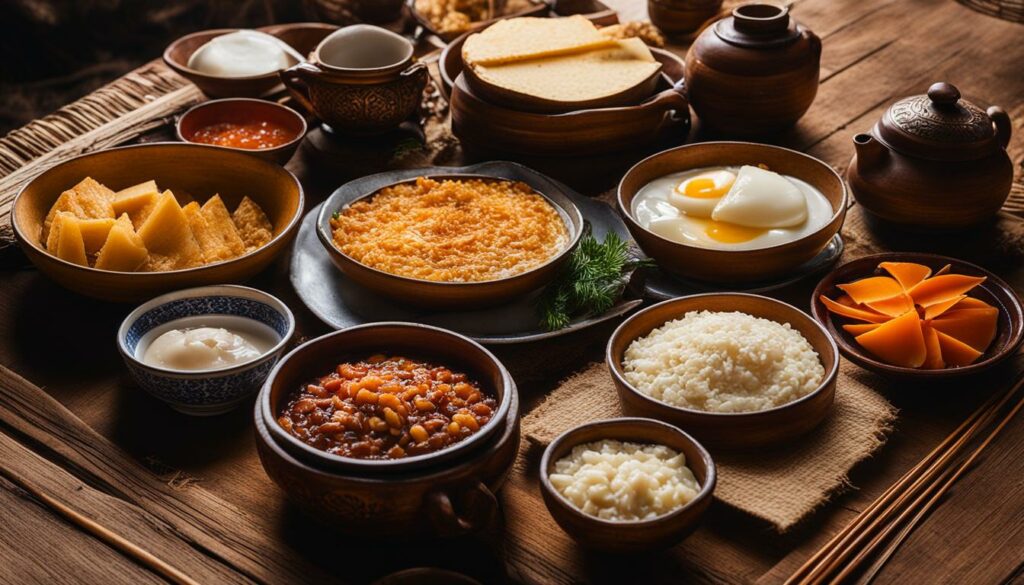
Mongolian breakfast is a celebration of flavors and textures that reflect the nomadic lifestyle and the culinary traditions passed down through generations. Iconic dishes like boortsog and tsuivan exemplify the unique characteristics and tastes of Mongolian breakfast.
Boortsog: Deep-Fried Pastries
Boortsog is a beloved Mongolian breakfast pastry that has become a cultural icon. These deep-fried pastries are made from a simple dough consisting of flour, butter, milk, and sugar. They are shaped into intricate patterns or unique designs before being fried to perfection. Boortsog are crunchy on the outside and slightly soft on the inside, making them a delightful treat to start the day.
Tsuivan: Stir-Fried Noodles
Tsuivan is a hearty and savory Mongolian breakfast dish that combines stir-fried noodles with meat and vegetables. The dish typically features thinly sliced meat, such as beef or mutton, stir-fried with a medley of onions, carrots, cabbage, and other seasonal vegetables. The noodles are then added, along with various seasonings and sauces, resulting in a flavorful and satisfying breakfast option.
| Dish | Description |
|---|---|
| Boortsog | A deep-fried pastry made from a buttery dough, shaped into unique patterns. |
| Tsuivan | Stir-fried noodles with thinly sliced meat, vegetables, and flavorful seasonings. |
Mongolia’s culinary heritage is deeply rooted in its nomadic lifestyle, and breakfast is a testament to the nourishment required for a demanding day on the steppes. By savoring the flavors and textures of traditional Mongolian breakfast, you can experience a taste of the nomadic lifestyle and appreciate the resilience and resourcefulness of the Mongolian people.
Staple Foods in Mongolian Breakfast
Mongolian breakfast is a hearty affair, featuring staple foods that provide energy and sustenance to start the day right. The breakfast table in Mongolia is laden with a delightful array of dishes that showcase the country’s unique culinary heritage. From tsampa and grains to dairy products and meat, each element contributes to a nourishing and flavorsome morning meal.
Tsampa: Tsampa, a roasted barley flour porridge, takes center stage in Mongolian breakfasts. This traditional dish is made by toasting barley flour and mixing it with hot water or milk. Tsampa can be enhanced with the addition of butter or dried fruit, adding richness and sweetness to its nutty flavor.
Grains: Grains play a crucial role in Mongolian breakfasts, providing carbohydrates and fiber. They are used to make various bread and pastry dishes, such as boortsog and buuz. Boortsog are deep-fried pastries with a crispy exterior and a tender interior, perfect for dipping in tea or tsampa. Buuz, on the other hand, are steamed dumplings filled with meat and spices, offering a savory and satisfying start to the day.
Dairy Products: No Mongolian breakfast is complete without dairy products. These include milk and yogurt, which are excellent sources of essential nutrients like calcium and protein. Mongolian dairy products are renowned for their quality and taste, often reflecting the country’s nomadic heritage and dedication to traditional production methods.
Meat: Meat dishes also make an appearance on the Mongolian breakfast table, providing a protein boost for sustained energy throughout the day. Tsuivan, a stir-fried noodle dish with meat and vegetables, is a popular choice. It combines the heartiness of meat with the comfort of noodles, creating a satisfying and flavorful breakfast option. Buuz, mentioned earlier, can be filled with seasoned meat, offering a more substantial and indulgent breakfast experience.
Overall, Mongolian breakfasts are a celebration of staple foods that have nourished generations of nomads. From the comforting warmth of tsampa to the savory delights of meat dishes, each component contributes to a delightful breakfast experience that embodies the rich culinary traditions of Mongolia.
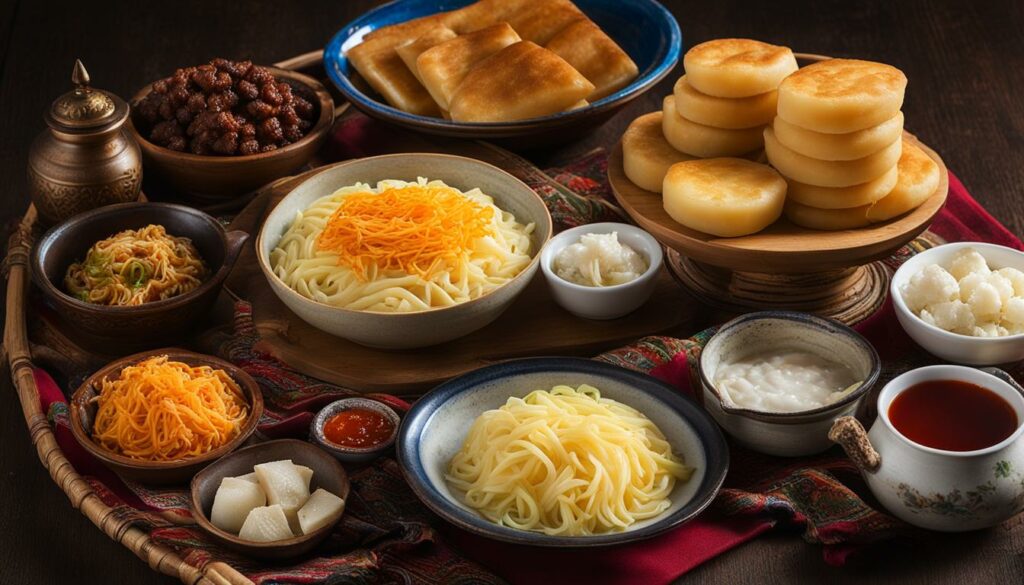
Continue reading to explore the range of beverages that complement the flavors of Mongolian breakfast.
Beverages in Mongolian Breakfast
When it comes to a traditional Mongolian breakfast, delicious beverages play an important role in complementing the flavors of the food. One such iconic beverage is suutei tsai, a hot milk tea that is popular among locals and visitors alike. Suutei tsai stands out with its unique combination of salty and creamy flavors, making it a delightful way to start your day.
In addition to suutei tsai, Mongolian breakfast offers a variety of other traditional drinks that add to the overall breakfast experience. If you’re in the mood for something different, try dalai tea, a soothing herbal tea that is known for its calming qualities. For an authentic taste of Mongolian culture, why not indulge in airag, a fermented horse milk beverage traditionally enjoyed by nomadic herders? And if you prefer a refreshing yogurt-based drink, tarag is the perfect choice.
These delightful beverages not only provide hydration, but they also offer a glimpse into the rich culinary heritage of Mongolia. With a focus on dairy products and traditional drinks, Mongolian breakfast offers a unique and satisfying mealtime experience. So, next time you find yourself in Mongolia, be sure to savor these beverages and immerse yourself in the flavors of this fascinating culture.
FAQ
What is Byaslag cheese?
Byaslag cheese is a traditional Mongolian dairy product. It is a creamy and delicious cheese that is made from fermented and dried curds, giving it a unique texture and flavor.
How is Byaslag cheese made?
Byaslag cheese is made by sourcing milk, fermenting it, and then drying the curds under the Mongolian sun. This process gives the cheese its distinct taste and texture.
Where can I find Byaslag cheese?
Byaslag cheese can be found in Mongolia, where it is a popular and traditional dairy product. It can also be found in some specialty food stores worldwide or purchased online.
How can I use Byaslag cheese in cooking?
Byaslag cheese is versatile and can be used in various dishes. It can be eaten on its own as a snack, crumbled over salads, melted in sandwiches, or used as a topping for soups and stews.
What are the health benefits of Byaslag cheese?
Byaslag cheese is a rich source of protein and calcium, making it a nutritious addition to your diet. It also contains beneficial bacteria that can support gut health.
Is Byaslag cheese suitable for vegetarians?
Byaslag cheese is made from milk and does not contain any animal rennet, making it suitable for vegetarians to consume.
How long does Byaslag cheese last?
Byaslag cheese has a long shelf-life due to its drying process. It can be stored in a cool and dry place for several months. However, its texture and flavor may change over time.
Can I freeze Byaslag cheese?
It is not recommended to freeze Byaslag cheese as it may alter its texture and affect the overall quality.
What other traditional Mongolian dairy products are there?
In addition to Byaslag cheese, Mongolia also has other traditional dairy products like Aaruul (dried curds) and Suutei Tsai (salted milk tea), which are deeply rooted in Mongolian culture and cuisine.
How do Aaruul and Suutei Tsai represent Mongolian dairy heritage?
Aaruul and Suutei Tsai are iconic Mongolian dairy products that symbolize the cultural richness and resilience of Mongolia’s dairy heritage. These products have long been a part of Mongolian culinary traditions, offering unique tastes and serving as symbols of hospitality and everyday comfort.







